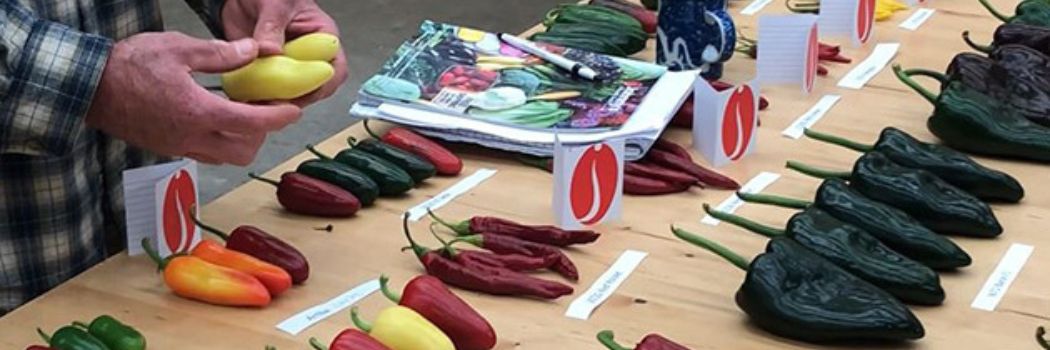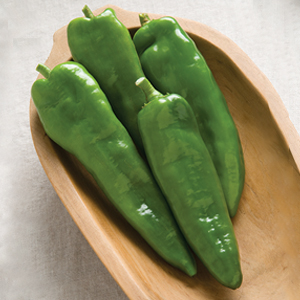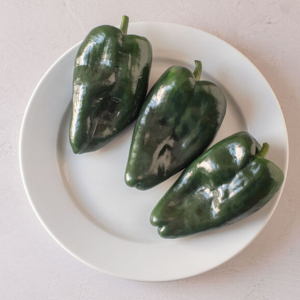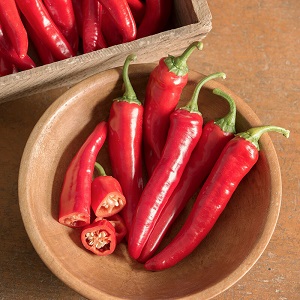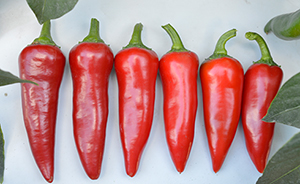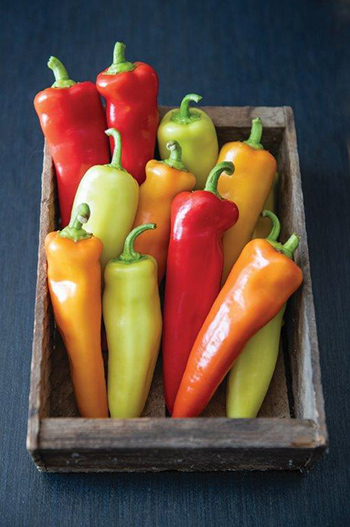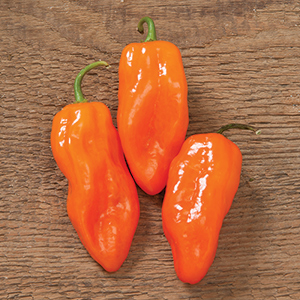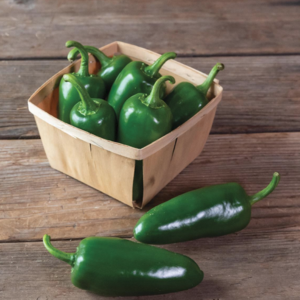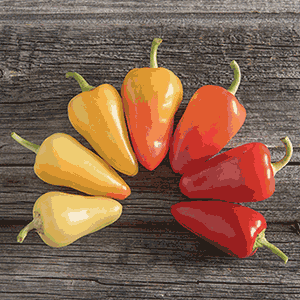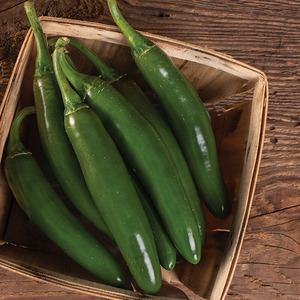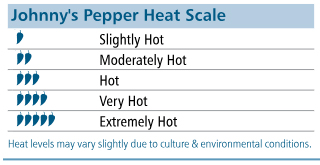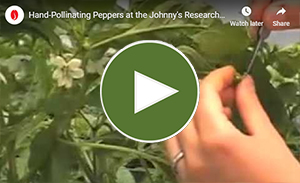- Sweet Bell Peppers | Variety Comparison Chart (PDF)
- Peppers | Key Growing Information
- Corno di Toro and Cornito Sweet Peppers Bred by Johnny's
- 'Sprinter' Red Bell Pepper Variety From Johnny's
- Video: Growing Peppers in Containers with Niki Jabbour & Johnny's
- Pepper Picks: Bells & Jalapeños | Johnny's Webinar Series
- Video: How to Grow Peppers • From Seed to Harvest
- Restoration of OP 'Hungarian Hot Wax' Pepper | Exclusively from Johnny's Selected Seeds
- Pepper Picks: Bells & Jalapeños | Johnny's Webinar Series
- 'Olly' Early-Yielding Red Bell Pepper Variety From Johnny's
- Video: Peppers: Mostly Sweet with a Touch of Heat | Johnny's Webinar Series
- 'Lilo' Purple Bell Pepper Variety From Johnny's
- 'Carmen' Corno di Toro Sweet Pepper in the Greenhouse
- Field-Grown Pepper Production Guide | Tech Sheet (PDF)
- Greenhouse Bell Pepper Production Guide | Tech Sheet (PDF)
- Greenhouse Peppers | Key Growing Information
- Video: Hand-Pollinating Peppers at Our Research Farm | Classical Plant Breeding at Johnny's Selected Seeds
- Late-Summer Recipe Preview with Farmer-Chef Frank Giglio | Three Lily Farm, Thorndike, Maine
- Johnny's Corno di Toro Peppers Rule | Press Release
- Peppers: Mostly Sweet with a Touch of Heat | Johnny's Educational Webinar Resources
- 'Brocanto' Yellow Bell Pepper Variety From Johnny's
- Jalapeño Pepper Varieties From Johnny's
- Johnny's Hot Pepper Palooza | 10 Types of Chili Peppers to Bring the Heat to Your Harvest
- How to Grow Great Pepper Seedlings | Tips for Successful Transplants
- Basket-weave Trellising Instructions for Tomato & Pepper Plants | Tech Sheet (PDF)
- 'Milena' Orange Bell Pepper Variety From Johnny's
- 'Paisan' Organic Pepperoncini Bred by Johnny's
- Johnny’s OP Stewardship Project: Restoration of ‘Hungarian Hot Wax’ Pepper
Johnny's Hot Pepper Palooza: 10 Types of Chili Peppers to Bring the Heat to Your Harvest
 Steve Bellavia has worked for Johnny's for 30 years, 4 in the sales department and the remainder devoted to conducting vegetable research on the farm. As a Product Manager, Steve oversees our pepper program as well as most of our heading brassicas, rutabaga, parsnips, and other less common root vegetables. He is responsible for managing our assortment of these crops.
Steve Bellavia has worked for Johnny's for 30 years, 4 in the sales department and the remainder devoted to conducting vegetable research on the farm. As a Product Manager, Steve oversees our pepper program as well as most of our heading brassicas, rutabaga, parsnips, and other less common root vegetables. He is responsible for managing our assortment of these crops.
So Hot, They're Cool
Demand for hot peppers is up, up, up, and supply is in hot pursuit, according to Fresh Plaza, a worldwide news aggregator for the fresh produce industry. While capsicum devotees seek out and get creative with the hots, market farmers and growers are sowing, growing, and marketing them with equal ardor and zeal.
Meanwhile back at the research farm, Johnny's invests considerable time and energy toward sourcing, breeding, trialing, refining, and selecting the most promising pepper varieties from around the globe. From the hundreds we plant and scrutinize annually, only those that exhibit reliably superior performance and flavor make it into our line-up.
This year we've expanded our line of peppers to offer even more options for a diversity of consumers—from specialty ethnic markets to foodies to high-end chefs with a nose for the novel. Looking to add new varieties to this year's grow list? To help you choose, we've drawn up this compendium of 10 popular types of Hot Peppers we offer: from Anaheim to Cayenne, Padrón to Hot Wax, we touch on origin, cultural, and culinary features. And for pepperheads of all magnitudes, we've included some tidbits about capsaicin and the Scoville Heat Scale.
1 • Anaheim/Numex
- Heat Scale:
 Slightly Hot
Slightly Hot
- Early & productive, even in cooler regions.
- Provenance
- These peppers have a couple of alternate names: Anaheim is the city in southern California where this type of chili is said to have been brought from New Mexico in the late 1800's. Numex signifies the likelihood that a pepper's forebears were bred at New Mexico State University. Dating back to 1888, NMSU is home of the longest known continuous program of chili pepper improvement.
- Culinary Features & Uses
- This type is widely available, and one of the most common chili types in the US.
- Though relatively mild in heat, the flavor is sharp and somewhat acidic.
- Usually used when green; can also be used when red.
- In New Mexico, Anaheim/Numex peppers are commonly sliced and fried and served as a side dish.
- Nice roasted and eaten as a snack or appetizer.
- Sometimes used to make chili rellanos for those who find Poblanos too spicy.
- Red varieties are often strung together to create ristras.
- Recommended Variety
- An organic variety bred by Johnny's, 'Highlander' is easy to grow, with good adaptability and excellent flavor. It is early and productive, even in cooler areas.
2 • Ancho / Poblano
- Heat Scale:
 Moderately Hot
Moderately Hot
- Classic flat grilling pepper.
- Provenance
- Originated in Puebla, Mexico.
- Culinary Features
- Moderately thick walls allow them to hold up when stuffed.
- When fresh they are called poblanos; when dried, they are called ancho, Spanish for "wide chili."
- Recommended Variety
- 'Sargento': This classic flat, semi-heart-shaped poblano is well-suited for grilling and stuffing for chiles rellenos.
3 • Cayenne Chili
- Heat Scale:
 Moderately Hot
Moderately Hot
- Versatile and flavorful Cayenne excellent for fresh eating or for drying.
- Provenance
- Said to have originated in Cayenne, the capital city of French Guiana, which derives in turn from the Tupi Indian word, kyinha.
- Culinary Features
- Heat Scale:
 Moderately Hot to
Moderately Hot to  Very Hot
Very Hot
- Excellent fresh, cooked, or dried.
- Piquant, orange to deep-red fruits are typically ground into powder or flakes for use as seasoning.
- The dried powder is excellent for making kimchee.
- They are excellent for providing both heat and flavor to many different cuisines.
- Recommended Variety
- 'Red Ember' is an AAS Award-winning, Johnny's-Bred cayenne prized for its versatility and a smoky-sweet/moderate-heat flavor. Great for using fresh in recipes or for chili powder or flakes sprinkled on cooked foods. Read more about Red Ember's culinary properties in our Recipe Preview for Sambal Matah, a Balinese relish, with New York Times Bestselling chef Frank Giglio, of Three Lily Farms.
4 • Fresno
- Heat Scale:
 Moderately Hot
Moderately Hot
- Widely adapted, flavorful sweet heat.
- Provenance
- Bred by Clarence Brown Hamlin and released in 1952, this type is named for Fresno, California. Fresno peppers are widely grown throughout California, where they are available nearly year-round.
- Culinary Features
- Highly versatile, whether green/immature or red/ripe.
- Its medium heat level makes it appealing to a wide variety of cuisines and recipes.
- Typically used fresh for garnishes, in relishes, salsa, or ceviche; added to stir-fries and hot sauce; or sautéed.
- Thick walls make them suitable for stuffing, but they are not recommended for drying.
- Recommended Variety
- 'Flaming Flare' is a widely adapted, AAS award-winning variety with a flavor that nicely combines sweetness with heat.
5 • Hot Wax
- Heat Scale:
 Moderately Hot
Moderately Hot
- Sets fruits well under cool, wet conditions when other varieties may not.
- Provenance
- Originates from Central Europe.
- Growing Tip
- Easy to grow.
- Culinary Features
- Tasty used at the yellow, orange, or red stage.
- Excellent for frying, roasting, or pickling.
- Recommended Variety
- 'Hungarian Hot Wax' is our newly selected strain featuring more uniform fruits and an improved plant architecture compared to other available strains. Smooth, tapered, and moderately spicy fruits avg. 5 1/2" x 1 1/2" and mature from pale yellow to orange red, and finally, to a vibrant red.
6 • Habanero
- Heat Scale:
 Extremely Hot
Extremely Hot
- A hybrid habanero that's early and hot—we give it a 5!
- Provenance
- A subtype of Capsicum chinense, records suggest the habanero originated in the Yucatàn Peninsula–Cuban archipelagic region of the Caribbean.
- Habanero means "from Havana."
- Growing Tip
- The habanero genotypes, in general, including 'Helios,' can be slower than other types, so may be sown a week or two earlier than other sweet and hot peppers.
- Culinary Features
- Like many hot peppers, pungency in this group varies by cultivar as well as by the region in which they are grown. The fruits will be hotter in hot, dry weather than in cool, wet weather.
- Regarded as integral to many Yucatecan and Caribbean food, particularly in the form of salsas, purées, and hot sauces such as jerk sauce.
- Recommended Variety
- 'Helios': Early, extremely hot habanero with shiny, vibrant orange coloration when ripe. Adaptable to long- or short-season production. Use sparingly in salsas, bean stews, or Indian curries for its heat and floral notes. Can also be chopped and added fresh to chutneys, salsas, and sauces; pickled; dried; or made into jelly.
7 • Jalapeño
- Heat Scale:
 Hot
Hot
- Widely adapted and high yielding.
- Provenance
- As with so many other types of peppers, jalapeños are named for the region where they were traditionally cultivated: Jalapa, the capital city of Veracruz, Mexico. Spanish for "from Xalapa," jalapa is a word of Nahuatl (an Aztec language) origin, formed from the roots xālli "sand" + āpan "water place."
- Jalapeños remain the most widely used hot pepper in Mexico as well as the United states.
- Growing Tip
- The thin, slight cracking on the skin of the fruits is called checking, a trait positively correlated with maturity and heat level. Nowadays checking is generally considered cosmetically undesirable and modern varieties have been bred to be slow to check.
- Culinary Features
- This most common of pepper types is prepared in a variety of ways and featured as an ingredient in many types of recipes; they can be stuffed and served cooked or raw, pickled and served atop nachos, smoked (chipotles), jellied, sautéed in oil (chile toreados), chopped into salsas and chilis, and served alongside phở and bánh mì in place of the less widely available, fresh Thai chilis.
- Recommended Varieties
- 'Pantera': Large fruits and big plants that produce abundant yields over a long period of time.
- 'Arriba': This high-yielding, Caribe (pronounced ka-ree'-bay) type delicious at all stages of ripeness. Usually used when yellow, but it also goes through a colorful range of stages before finally turning red, all of which are delicious.
- 'Jalafuego': Available as organic or conventional seeds. Large and strong, disease-resistant plants produce abundant yields of smooth, spicy fruits that are perfect for poppers, salsa, canning, freezing, or drying.
Can be harvested when green or red.
8 • Padrón
- Heat Scale:
 Slightly Hot
Slightly Hot
- Organic, open-pollinated heirloom.
- Provenance
- Also known as pementos de Padrón, from the Padrón municipality within the autonomous community of Galicia in Northwestern Spain.
- Culinary Features
- Os pementos de Padrón, uns pican e outros non ("Padrón peppers, some are hot, some are not").
- Harvested before reaching 2–3" in length, fruits will be mild except for a small proportion that may be hot.
- Fruits all become hot if allowed to grow to 2" or longer. To some extent, level of heat is also governed by water, sunlight, and temperature.
- Typically sauteed in olive oil and salt. Add a few sliced garlic cloves for extra pizazz.
- Recommended Variety:
- 'Padrón': This eponymous, open-pollinated heirloom is widely enjoyed for tapas.
9 • Santa Fe
- Heat Scale:
 Extremely Hot
Extremely Hot
- A widely-adapted, high-yielding Guero type great for spiced-up chili rellanos.
- Provenance
- Originated in Southwestern US, New Mexico–Arizona region.
- Culinary Features
- Thick-walled and conical.
- Great for stuffing, frying or pickling.
- Recommended Variety:
- 'Havasu': Often harvested for pickling when yellow, they can also be used in their riper red stage. This is a blistering-hot pepper that can be used to lend sizzle to variety of dishes.
10 • Serrano
- Heat Scale:
 Extremely Hot
Extremely Hot
- Easy to grow, great for containers, and wicked hot!
- Provenance
- Originated in the mountainous regions of the Mexican states of Puebla and Hidalgo.
- Growing Tip
- Easy to grow.
- Culinary Features
- Similar flavor to jalapeños, but spicier.
- Excellent cooked, pickled, or raw in salsa.
- Fleshiness makes them well-suited to pico de gallo and salsa.
- Makes an excellent, hotter version of chipotles than jalapeños.
- Recommended Varieties
- 'Altiplano' and 'Santo Domingo': fast to harvest with traditional serrano flavor and reliably hot.
Dial up the Scoville Heat Scale
Some Like It Hot
Ever wonder what causes the buzzing sensation on your lips and tongue when you eat a hot pepper? Credit goes to a whole group of phytochemicals called capsaicinoids, the concentrations of which contribute to their pungency.
The subcomponent of capcsaicinoids that is responsible for their pungency is capsaicin, or CPS to molecular biologists. Capsaicin stimulates our nerve cells to create the tingling, redness, and sweating associated with pepper consumption. At the cellular level, CPS has been studied for its ability to induce a process called nonshivering thermogenesis, in which cells burn energy to release heat, increasing our metabolism and body temperature.
The author of one study notes capsaicin as the "first natural drug" known to augment the thermogenesis process, helping to explain some of its effects on the health of the body.
- Heat Scale:
Slightly Hot
- Early & productive, even in cooler regions.
- These peppers have a couple of alternate names: Anaheim is the city in southern California where this type of chili is said to have been brought from New Mexico in the late 1800's. Numex signifies the likelihood that a pepper's forebears were bred at New Mexico State University. Dating back to 1888, NMSU is home of the longest known continuous program of chili pepper improvement.
- This type is widely available, and one of the most common chili types in the US.
- Though relatively mild in heat, the flavor is sharp and somewhat acidic.
- Usually used when green; can also be used when red.
- In New Mexico, Anaheim/Numex peppers are commonly sliced and fried and served as a side dish.
- Nice roasted and eaten as a snack or appetizer.
- Sometimes used to make chili rellanos for those who find Poblanos too spicy.
- Red varieties are often strung together to create ristras.
- An organic variety bred by Johnny's, 'Highlander' is easy to grow, with good adaptability and excellent flavor. It is early and productive, even in cooler areas.
- Heat Scale:
Moderately Hot
- Classic flat grilling pepper.
- Provenance
- Originated in Puebla, Mexico.
- Culinary Features
- Moderately thick walls allow them to hold up when stuffed.
- When fresh they are called poblanos; when dried, they are called ancho, Spanish for "wide chili."
- Recommended Variety
- 'Sargento': This classic flat, semi-heart-shaped poblano is well-suited for grilling and stuffing for chiles rellenos.
3 • Cayenne Chili
- Heat Scale:
 Moderately Hot
Moderately Hot
- Versatile and flavorful Cayenne excellent for fresh eating or for drying.
- Provenance
- Said to have originated in Cayenne, the capital city of French Guiana, which derives in turn from the Tupi Indian word, kyinha.
- Culinary Features
- Heat Scale:
 Moderately Hot to
Moderately Hot to  Very Hot
Very Hot
- Excellent fresh, cooked, or dried.
- Piquant, orange to deep-red fruits are typically ground into powder or flakes for use as seasoning.
- The dried powder is excellent for making kimchee.
- They are excellent for providing both heat and flavor to many different cuisines.
- Recommended Variety
- 'Red Ember' is an AAS Award-winning, Johnny's-Bred cayenne prized for its versatility and a smoky-sweet/moderate-heat flavor. Great for using fresh in recipes or for chili powder or flakes sprinkled on cooked foods. Read more about Red Ember's culinary properties in our Recipe Preview for Sambal Matah, a Balinese relish, with New York Times Bestselling chef Frank Giglio, of Three Lily Farms.
4 • Fresno
- Heat Scale:
 Moderately Hot
Moderately Hot
- Widely adapted, flavorful sweet heat.
- Provenance
- Bred by Clarence Brown Hamlin and released in 1952, this type is named for Fresno, California. Fresno peppers are widely grown throughout California, where they are available nearly year-round.
- Culinary Features
- Highly versatile, whether green/immature or red/ripe.
- Its medium heat level makes it appealing to a wide variety of cuisines and recipes.
- Typically used fresh for garnishes, in relishes, salsa, or ceviche; added to stir-fries and hot sauce; or sautéed.
- Thick walls make them suitable for stuffing, but they are not recommended for drying.
- Recommended Variety
- 'Flaming Flare' is a widely adapted, AAS award-winning variety with a flavor that nicely combines sweetness with heat.
5 • Hot Wax
- Heat Scale:
 Moderately Hot
Moderately Hot
- Sets fruits well under cool, wet conditions when other varieties may not.
- Provenance
- Originates from Central Europe.
- Growing Tip
- Easy to grow.
- Culinary Features
- Tasty used at the yellow, orange, or red stage.
- Excellent for frying, roasting, or pickling.
- Recommended Variety
- 'Hungarian Hot Wax' is our newly selected strain featuring more uniform fruits and an improved plant architecture compared to other available strains. Smooth, tapered, and moderately spicy fruits avg. 5 1/2" x 1 1/2" and mature from pale yellow to orange red, and finally, to a vibrant red.
6 • Habanero
- Heat Scale:
 Extremely Hot
Extremely Hot
- A hybrid habanero that's early and hot—we give it a 5!
- Provenance
- A subtype of Capsicum chinense, records suggest the habanero originated in the Yucatàn Peninsula–Cuban archipelagic region of the Caribbean.
- Habanero means "from Havana."
- Growing Tip
- The habanero genotypes, in general, including 'Helios,' can be slower than other types, so may be sown a week or two earlier than other sweet and hot peppers.
- Culinary Features
- Like many hot peppers, pungency in this group varies by cultivar as well as by the region in which they are grown. The fruits will be hotter in hot, dry weather than in cool, wet weather.
- Regarded as integral to many Yucatecan and Caribbean food, particularly in the form of salsas, purées, and hot sauces such as jerk sauce.
- Recommended Variety
- 'Helios': Early, extremely hot habanero with shiny, vibrant orange coloration when ripe. Adaptable to long- or short-season production. Use sparingly in salsas, bean stews, or Indian curries for its heat and floral notes. Can also be chopped and added fresh to chutneys, salsas, and sauces; pickled; dried; or made into jelly.
7 • Jalapeño
- Heat Scale:
 Hot
Hot
- Widely adapted and high yielding.
- Provenance
- As with so many other types of peppers, jalapeños are named for the region where they were traditionally cultivated: Jalapa, the capital city of Veracruz, Mexico. Spanish for "from Xalapa," jalapa is a word of Nahuatl (an Aztec language) origin, formed from the roots xālli "sand" + āpan "water place."
- Jalapeños remain the most widely used hot pepper in Mexico as well as the United states.
- Growing Tip
- The thin, slight cracking on the skin of the fruits is called checking, a trait positively correlated with maturity and heat level. Nowadays checking is generally considered cosmetically undesirable and modern varieties have been bred to be slow to check.
- Culinary Features
- This most common of pepper types is prepared in a variety of ways and featured as an ingredient in many types of recipes; they can be stuffed and served cooked or raw, pickled and served atop nachos, smoked (chipotles), jellied, sautéed in oil (chile toreados), chopped into salsas and chilis, and served alongside phở and bánh mì in place of the less widely available, fresh Thai chilis.
- Recommended Varieties
- 'Pantera': Large fruits and big plants that produce abundant yields over a long period of time.
- 'Arriba': This high-yielding, Caribe (pronounced ka-ree'-bay) type delicious at all stages of ripeness. Usually used when yellow, but it also goes through a colorful range of stages before finally turning red, all of which are delicious.
- 'Jalafuego': Available as organic or conventional seeds. Large and strong, disease-resistant plants produce abundant yields of smooth, spicy fruits that are perfect for poppers, salsa, canning, freezing, or drying.
Can be harvested when green or red.
8 • Padrón
- Heat Scale:
 Slightly Hot
Slightly Hot
- Organic, open-pollinated heirloom.
- Provenance
- Also known as pementos de Padrón, from the Padrón municipality within the autonomous community of Galicia in Northwestern Spain.
- Culinary Features
- Os pementos de Padrón, uns pican e outros non ("Padrón peppers, some are hot, some are not").
- Harvested before reaching 2–3" in length, fruits will be mild except for a small proportion that may be hot.
- Fruits all become hot if allowed to grow to 2" or longer. To some extent, level of heat is also governed by water, sunlight, and temperature.
- Typically sauteed in olive oil and salt. Add a few sliced garlic cloves for extra pizazz.
- Recommended Variety:
- 'Padrón': This eponymous, open-pollinated heirloom is widely enjoyed for tapas.
9 • Santa Fe
- Heat Scale:
 Extremely Hot
Extremely Hot
- A widely-adapted, high-yielding Guero type great for spiced-up chili rellanos.
- Provenance
- Originated in Southwestern US, New Mexico–Arizona region.
- Culinary Features
- Thick-walled and conical.
- Great for stuffing, frying or pickling.
- Recommended Variety:
- 'Havasu': Often harvested for pickling when yellow, they can also be used in their riper red stage. This is a blistering-hot pepper that can be used to lend sizzle to variety of dishes.
10 • Serrano
- Heat Scale:
 Extremely Hot
Extremely Hot
- Easy to grow, great for containers, and wicked hot!
- Provenance
- Originated in the mountainous regions of the Mexican states of Puebla and Hidalgo.
- Growing Tip
- Easy to grow.
- Culinary Features
- Similar flavor to jalapeños, but spicier.
- Excellent cooked, pickled, or raw in salsa.
- Fleshiness makes them well-suited to pico de gallo and salsa.
- Makes an excellent, hotter version of chipotles than jalapeños.
- Recommended Varieties
- 'Altiplano' and 'Santo Domingo': fast to harvest with traditional serrano flavor and reliably hot.
Dial up the Scoville Heat Scale
Some Like It Hot
Ever wonder what causes the buzzing sensation on your lips and tongue when you eat a hot pepper? Credit goes to a whole group of phytochemicals called capsaicinoids, the concentrations of which contribute to their pungency.
The subcomponent of capcsaicinoids that is responsible for their pungency is capsaicin, or CPS to molecular biologists. Capsaicin stimulates our nerve cells to create the tingling, redness, and sweating associated with pepper consumption. At the cellular level, CPS has been studied for its ability to induce a process called nonshivering thermogenesis, in which cells burn energy to release heat, increasing our metabolism and body temperature.
The author of one study notes capsaicin as the "first natural drug" known to augment the thermogenesis process, helping to explain some of its effects on the health of the body.
- Heat Scale:
Moderately Hot
- Versatile and flavorful Cayenne excellent for fresh eating or for drying.
- Said to have originated in Cayenne, the capital city of French Guiana, which derives in turn from the Tupi Indian word, kyinha.
- Heat Scale:
Moderately Hot to
Very Hot
- Excellent fresh, cooked, or dried.
- Piquant, orange to deep-red fruits are typically ground into powder or flakes for use as seasoning.
- The dried powder is excellent for making kimchee.
- They are excellent for providing both heat and flavor to many different cuisines.
- 'Red Ember' is an AAS Award-winning, Johnny's-Bred cayenne prized for its versatility and a smoky-sweet/moderate-heat flavor. Great for using fresh in recipes or for chili powder or flakes sprinkled on cooked foods. Read more about Red Ember's culinary properties in our Recipe Preview for Sambal Matah, a Balinese relish, with New York Times Bestselling chef Frank Giglio, of Three Lily Farms.
- Heat Scale:
Moderately Hot
- Widely adapted, flavorful sweet heat.
- Provenance
- Bred by Clarence Brown Hamlin and released in 1952, this type is named for Fresno, California. Fresno peppers are widely grown throughout California, where they are available nearly year-round.
- Culinary Features
- Highly versatile, whether green/immature or red/ripe.
- Its medium heat level makes it appealing to a wide variety of cuisines and recipes.
- Typically used fresh for garnishes, in relishes, salsa, or ceviche; added to stir-fries and hot sauce; or sautéed.
- Thick walls make them suitable for stuffing, but they are not recommended for drying.
- Recommended Variety
- 'Flaming Flare' is a widely adapted, AAS award-winning variety with a flavor that nicely combines sweetness with heat.
5 • Hot Wax
- Heat Scale:
 Moderately Hot
Moderately Hot
- Sets fruits well under cool, wet conditions when other varieties may not.
- Provenance
- Originates from Central Europe.
- Growing Tip
- Easy to grow.
- Culinary Features
- Tasty used at the yellow, orange, or red stage.
- Excellent for frying, roasting, or pickling.
- Recommended Variety
- 'Hungarian Hot Wax' is our newly selected strain featuring more uniform fruits and an improved plant architecture compared to other available strains. Smooth, tapered, and moderately spicy fruits avg. 5 1/2" x 1 1/2" and mature from pale yellow to orange red, and finally, to a vibrant red.
6 • Habanero
- Heat Scale:
 Extremely Hot
Extremely Hot
- A hybrid habanero that's early and hot—we give it a 5!
- Provenance
- A subtype of Capsicum chinense, records suggest the habanero originated in the Yucatàn Peninsula–Cuban archipelagic region of the Caribbean.
- Habanero means "from Havana."
- Growing Tip
- The habanero genotypes, in general, including 'Helios,' can be slower than other types, so may be sown a week or two earlier than other sweet and hot peppers.
- Culinary Features
- Like many hot peppers, pungency in this group varies by cultivar as well as by the region in which they are grown. The fruits will be hotter in hot, dry weather than in cool, wet weather.
- Regarded as integral to many Yucatecan and Caribbean food, particularly in the form of salsas, purées, and hot sauces such as jerk sauce.
- Recommended Variety
- 'Helios': Early, extremely hot habanero with shiny, vibrant orange coloration when ripe. Adaptable to long- or short-season production. Use sparingly in salsas, bean stews, or Indian curries for its heat and floral notes. Can also be chopped and added fresh to chutneys, salsas, and sauces; pickled; dried; or made into jelly.
7 • Jalapeño
- Heat Scale:
 Hot
Hot
- Widely adapted and high yielding.
- Provenance
- As with so many other types of peppers, jalapeños are named for the region where they were traditionally cultivated: Jalapa, the capital city of Veracruz, Mexico. Spanish for "from Xalapa," jalapa is a word of Nahuatl (an Aztec language) origin, formed from the roots xālli "sand" + āpan "water place."
- Jalapeños remain the most widely used hot pepper in Mexico as well as the United states.
- Growing Tip
- The thin, slight cracking on the skin of the fruits is called checking, a trait positively correlated with maturity and heat level. Nowadays checking is generally considered cosmetically undesirable and modern varieties have been bred to be slow to check.
- Culinary Features
- This most common of pepper types is prepared in a variety of ways and featured as an ingredient in many types of recipes; they can be stuffed and served cooked or raw, pickled and served atop nachos, smoked (chipotles), jellied, sautéed in oil (chile toreados), chopped into salsas and chilis, and served alongside phở and bánh mì in place of the less widely available, fresh Thai chilis.
- Recommended Varieties
- 'Pantera': Large fruits and big plants that produce abundant yields over a long period of time.
- 'Arriba': This high-yielding, Caribe (pronounced ka-ree'-bay) type delicious at all stages of ripeness. Usually used when yellow, but it also goes through a colorful range of stages before finally turning red, all of which are delicious.
- 'Jalafuego': Available as organic or conventional seeds. Large and strong, disease-resistant plants produce abundant yields of smooth, spicy fruits that are perfect for poppers, salsa, canning, freezing, or drying.
Can be harvested when green or red.
8 • Padrón
- Heat Scale:
 Slightly Hot
Slightly Hot
- Organic, open-pollinated heirloom.
- Provenance
- Also known as pementos de Padrón, from the Padrón municipality within the autonomous community of Galicia in Northwestern Spain.
- Culinary Features
- Os pementos de Padrón, uns pican e outros non ("Padrón peppers, some are hot, some are not").
- Harvested before reaching 2–3" in length, fruits will be mild except for a small proportion that may be hot.
- Fruits all become hot if allowed to grow to 2" or longer. To some extent, level of heat is also governed by water, sunlight, and temperature.
- Typically sauteed in olive oil and salt. Add a few sliced garlic cloves for extra pizazz.
- Recommended Variety:
- 'Padrón': This eponymous, open-pollinated heirloom is widely enjoyed for tapas.
9 • Santa Fe
- Heat Scale:
 Extremely Hot
Extremely Hot
- A widely-adapted, high-yielding Guero type great for spiced-up chili rellanos.
- Provenance
- Originated in Southwestern US, New Mexico–Arizona region.
- Culinary Features
- Thick-walled and conical.
- Great for stuffing, frying or pickling.
- Recommended Variety:
- 'Havasu': Often harvested for pickling when yellow, they can also be used in their riper red stage. This is a blistering-hot pepper that can be used to lend sizzle to variety of dishes.
10 • Serrano
- Heat Scale:
 Extremely Hot
Extremely Hot
- Easy to grow, great for containers, and wicked hot!
- Provenance
- Originated in the mountainous regions of the Mexican states of Puebla and Hidalgo.
- Growing Tip
- Easy to grow.
- Culinary Features
- Similar flavor to jalapeños, but spicier.
- Excellent cooked, pickled, or raw in salsa.
- Fleshiness makes them well-suited to pico de gallo and salsa.
- Makes an excellent, hotter version of chipotles than jalapeños.
- Recommended Varieties
- 'Altiplano' and 'Santo Domingo': fast to harvest with traditional serrano flavor and reliably hot.
Dial up the Scoville Heat Scale
Some Like It Hot
Ever wonder what causes the buzzing sensation on your lips and tongue when you eat a hot pepper? Credit goes to a whole group of phytochemicals called capsaicinoids, the concentrations of which contribute to their pungency.
The subcomponent of capcsaicinoids that is responsible for their pungency is capsaicin, or CPS to molecular biologists. Capsaicin stimulates our nerve cells to create the tingling, redness, and sweating associated with pepper consumption. At the cellular level, CPS has been studied for its ability to induce a process called nonshivering thermogenesis, in which cells burn energy to release heat, increasing our metabolism and body temperature.
The author of one study notes capsaicin as the "first natural drug" known to augment the thermogenesis process, helping to explain some of its effects on the health of the body.
- Heat Scale:
Moderately Hot
- Sets fruits well under cool, wet conditions when other varieties may not.
- Originates from Central Europe.
- Easy to grow.
- Tasty used at the yellow, orange, or red stage.
- Excellent for frying, roasting, or pickling.
- 'Hungarian Hot Wax' is our newly selected strain featuring more uniform fruits and an improved plant architecture compared to other available strains. Smooth, tapered, and moderately spicy fruits avg. 5 1/2" x 1 1/2" and mature from pale yellow to orange red, and finally, to a vibrant red.
- Heat Scale:
Extremely Hot
- A hybrid habanero that's early and hot—we give it a 5!
- Provenance
- A subtype of Capsicum chinense, records suggest the habanero originated in the Yucatàn Peninsula–Cuban archipelagic region of the Caribbean.
- Habanero means "from Havana."
- Growing Tip
- The habanero genotypes, in general, including 'Helios,' can be slower than other types, so may be sown a week or two earlier than other sweet and hot peppers.
- Culinary Features
- Like many hot peppers, pungency in this group varies by cultivar as well as by the region in which they are grown. The fruits will be hotter in hot, dry weather than in cool, wet weather.
- Regarded as integral to many Yucatecan and Caribbean food, particularly in the form of salsas, purées, and hot sauces such as jerk sauce.
- Recommended Variety
- 'Helios': Early, extremely hot habanero with shiny, vibrant orange coloration when ripe. Adaptable to long- or short-season production. Use sparingly in salsas, bean stews, or Indian curries for its heat and floral notes. Can also be chopped and added fresh to chutneys, salsas, and sauces; pickled; dried; or made into jelly.
7 • Jalapeño
- Heat Scale:
 Hot
Hot
- Widely adapted and high yielding.
- Provenance
- As with so many other types of peppers, jalapeños are named for the region where they were traditionally cultivated: Jalapa, the capital city of Veracruz, Mexico. Spanish for "from Xalapa," jalapa is a word of Nahuatl (an Aztec language) origin, formed from the roots xālli "sand" + āpan "water place."
- Jalapeños remain the most widely used hot pepper in Mexico as well as the United states.
- Growing Tip
- The thin, slight cracking on the skin of the fruits is called checking, a trait positively correlated with maturity and heat level. Nowadays checking is generally considered cosmetically undesirable and modern varieties have been bred to be slow to check.
- Culinary Features
- This most common of pepper types is prepared in a variety of ways and featured as an ingredient in many types of recipes; they can be stuffed and served cooked or raw, pickled and served atop nachos, smoked (chipotles), jellied, sautéed in oil (chile toreados), chopped into salsas and chilis, and served alongside phở and bánh mì in place of the less widely available, fresh Thai chilis.
- Recommended Varieties
- 'Pantera': Large fruits and big plants that produce abundant yields over a long period of time.
- 'Arriba': This high-yielding, Caribe (pronounced ka-ree'-bay) type delicious at all stages of ripeness. Usually used when yellow, but it also goes through a colorful range of stages before finally turning red, all of which are delicious.
- 'Jalafuego': Available as organic or conventional seeds. Large and strong, disease-resistant plants produce abundant yields of smooth, spicy fruits that are perfect for poppers, salsa, canning, freezing, or drying.
Can be harvested when green or red.
8 • Padrón
- Heat Scale:
 Slightly Hot
Slightly Hot
- Organic, open-pollinated heirloom.
- Provenance
- Also known as pementos de Padrón, from the Padrón municipality within the autonomous community of Galicia in Northwestern Spain.
- Culinary Features
- Os pementos de Padrón, uns pican e outros non ("Padrón peppers, some are hot, some are not").
- Harvested before reaching 2–3" in length, fruits will be mild except for a small proportion that may be hot.
- Fruits all become hot if allowed to grow to 2" or longer. To some extent, level of heat is also governed by water, sunlight, and temperature.
- Typically sauteed in olive oil and salt. Add a few sliced garlic cloves for extra pizazz.
- Recommended Variety:
- 'Padrón': This eponymous, open-pollinated heirloom is widely enjoyed for tapas.
9 • Santa Fe
- Heat Scale:
 Extremely Hot
Extremely Hot
- A widely-adapted, high-yielding Guero type great for spiced-up chili rellanos.
- Provenance
- Originated in Southwestern US, New Mexico–Arizona region.
- Culinary Features
- Thick-walled and conical.
- Great for stuffing, frying or pickling.
- Recommended Variety:
- 'Havasu': Often harvested for pickling when yellow, they can also be used in their riper red stage. This is a blistering-hot pepper that can be used to lend sizzle to variety of dishes.
10 • Serrano
- Heat Scale:
 Extremely Hot
Extremely Hot
- Easy to grow, great for containers, and wicked hot!
- Provenance
- Originated in the mountainous regions of the Mexican states of Puebla and Hidalgo.
- Growing Tip
- Easy to grow.
- Culinary Features
- Similar flavor to jalapeños, but spicier.
- Excellent cooked, pickled, or raw in salsa.
- Fleshiness makes them well-suited to pico de gallo and salsa.
- Makes an excellent, hotter version of chipotles than jalapeños.
- Recommended Varieties
- 'Altiplano' and 'Santo Domingo': fast to harvest with traditional serrano flavor and reliably hot.
Dial up the Scoville Heat Scale
Some Like It Hot
Ever wonder what causes the buzzing sensation on your lips and tongue when you eat a hot pepper? Credit goes to a whole group of phytochemicals called capsaicinoids, the concentrations of which contribute to their pungency.
The subcomponent of capcsaicinoids that is responsible for their pungency is capsaicin, or CPS to molecular biologists. Capsaicin stimulates our nerve cells to create the tingling, redness, and sweating associated with pepper consumption. At the cellular level, CPS has been studied for its ability to induce a process called nonshivering thermogenesis, in which cells burn energy to release heat, increasing our metabolism and body temperature.
The author of one study notes capsaicin as the "first natural drug" known to augment the thermogenesis process, helping to explain some of its effects on the health of the body.
- Heat Scale:
Hot
- Widely adapted and high yielding.
- As with so many other types of peppers, jalapeños are named for the region where they were traditionally cultivated: Jalapa, the capital city of Veracruz, Mexico. Spanish for "from Xalapa," jalapa is a word of Nahuatl (an Aztec language) origin, formed from the roots xālli "sand" + āpan "water place."
- Jalapeños remain the most widely used hot pepper in Mexico as well as the United states.
- The thin, slight cracking on the skin of the fruits is called checking, a trait positively correlated with maturity and heat level. Nowadays checking is generally considered cosmetically undesirable and modern varieties have been bred to be slow to check.
- This most common of pepper types is prepared in a variety of ways and featured as an ingredient in many types of recipes; they can be stuffed and served cooked or raw, pickled and served atop nachos, smoked (chipotles), jellied, sautéed in oil (chile toreados), chopped into salsas and chilis, and served alongside phở and bánh mì in place of the less widely available, fresh Thai chilis.
- 'Pantera': Large fruits and big plants that produce abundant yields over a long period of time.
- 'Arriba': This high-yielding, Caribe (pronounced ka-ree'-bay) type delicious at all stages of ripeness. Usually used when yellow, but it also goes through a colorful range of stages before finally turning red, all of which are delicious.
- 'Jalafuego': Available as organic or conventional seeds. Large and strong, disease-resistant plants produce abundant yields of smooth, spicy fruits that are perfect for poppers, salsa, canning, freezing, or drying. Can be harvested when green or red.
- Heat Scale:
Slightly Hot
- Organic, open-pollinated heirloom.
- Provenance
- Also known as pementos de Padrón, from the Padrón municipality within the autonomous community of Galicia in Northwestern Spain.
- Culinary Features
- Os pementos de Padrón, uns pican e outros non ("Padrón peppers, some are hot, some are not").
- Harvested before reaching 2–3" in length, fruits will be mild except for a small proportion that may be hot.
- Fruits all become hot if allowed to grow to 2" or longer. To some extent, level of heat is also governed by water, sunlight, and temperature.
- Typically sauteed in olive oil and salt. Add a few sliced garlic cloves for extra pizazz.
- Recommended Variety:
- 'Padrón': This eponymous, open-pollinated heirloom is widely enjoyed for tapas.
9 • Santa Fe
- Heat Scale:
 Extremely Hot
Extremely Hot
- A widely-adapted, high-yielding Guero type great for spiced-up chili rellanos.
- Provenance
- Originated in Southwestern US, New Mexico–Arizona region.
- Culinary Features
- Thick-walled and conical.
- Great for stuffing, frying or pickling.
- Recommended Variety:
- 'Havasu': Often harvested for pickling when yellow, they can also be used in their riper red stage. This is a blistering-hot pepper that can be used to lend sizzle to variety of dishes.
10 • Serrano
- Heat Scale:
 Extremely Hot
Extremely Hot
- Easy to grow, great for containers, and wicked hot!
- Provenance
- Originated in the mountainous regions of the Mexican states of Puebla and Hidalgo.
- Growing Tip
- Easy to grow.
- Culinary Features
- Similar flavor to jalapeños, but spicier.
- Excellent cooked, pickled, or raw in salsa.
- Fleshiness makes them well-suited to pico de gallo and salsa.
- Makes an excellent, hotter version of chipotles than jalapeños.
- Recommended Varieties
- 'Altiplano' and 'Santo Domingo': fast to harvest with traditional serrano flavor and reliably hot.
Dial up the Scoville Heat Scale
Some Like It Hot
Ever wonder what causes the buzzing sensation on your lips and tongue when you eat a hot pepper? Credit goes to a whole group of phytochemicals called capsaicinoids, the concentrations of which contribute to their pungency.
The subcomponent of capcsaicinoids that is responsible for their pungency is capsaicin, or CPS to molecular biologists. Capsaicin stimulates our nerve cells to create the tingling, redness, and sweating associated with pepper consumption. At the cellular level, CPS has been studied for its ability to induce a process called nonshivering thermogenesis, in which cells burn energy to release heat, increasing our metabolism and body temperature.
The author of one study notes capsaicin as the "first natural drug" known to augment the thermogenesis process, helping to explain some of its effects on the health of the body.
- Heat Scale:
Extremely Hot
- A widely-adapted, high-yielding Guero type great for spiced-up chili rellanos.
- Originated in Southwestern US, New Mexico–Arizona region.
- Thick-walled and conical.
- Great for stuffing, frying or pickling.
- 'Havasu': Often harvested for pickling when yellow, they can also be used in their riper red stage. This is a blistering-hot pepper that can be used to lend sizzle to variety of dishes.
- Heat Scale:
Extremely Hot
- Easy to grow, great for containers, and wicked hot!
- Originated in the mountainous regions of the Mexican states of Puebla and Hidalgo.
- Easy to grow.
- Similar flavor to jalapeños, but spicier.
- Excellent cooked, pickled, or raw in salsa.
- Fleshiness makes them well-suited to pico de gallo and salsa.
- Makes an excellent, hotter version of chipotles than jalapeños.
- 'Altiplano' and 'Santo Domingo': fast to harvest with traditional serrano flavor and reliably hot.
Some Like It Hot
Ever wonder what causes the buzzing sensation on your lips and tongue when you eat a hot pepper? Credit goes to a whole group of phytochemicals called capsaicinoids, the concentrations of which contribute to their pungency.
The subcomponent of capcsaicinoids that is responsible for their pungency is capsaicin, or CPS to molecular biologists. Capsaicin stimulates our nerve cells to create the tingling, redness, and sweating associated with pepper consumption. At the cellular level, CPS has been studied for its ability to induce a process called nonshivering thermogenesis, in which cells burn energy to release heat, increasing our metabolism and body temperature.
The author of one study notes capsaicin as the "first natural drug" known to augment the thermogenesis process, helping to explain some of its effects on the health of the body.
Hot chili peppers, are customarily categorized by their capsaicin content — their heat. They are commonly ranked on the Scoville Heat Unit (SHU) scale, on which a bell pepper contains 0 SHU, a Piquillo approximately 1000, a Guajillo approximately 3000, a Serrano 10,000–23,000, and a Habanero 350,000–570,000. The score on the scale represents the level of dilution required for the sensation of heat to disappear completely.
The prize for hottest pepper known changes hands over the years. Currently it's claimed by 'Pepper X,' at over 3 million Scoville Heat Units, bred by the same individual who created the 'Carolina Reaper,' a C. chinense cultivar bred in South Carolina. Some of us wax nostalgic for the days before 'Bhut Jolokia,' a C. chinense pepper from India, was toppled from it pedestal as the hottest, at a mere 1 million Scoville Heat Units.
Johnny's Pepper Heat Scale
At Johnny's, we rank our peppers on a relative scale of heat, from slightly hot to extremely hot, designated with 1 to 5 pepper icons. We prefer this shorthand version because of the wide variation in SHUs, both between crops of the same variety when grown under different conditions, individual plants within a single crop, and even peppers from the same plant. Look for the pepper icons in the Quick Facts boxes of our product webpages and alongside each variety in the Hot Pepper section of our catalog.
Learn More
We hope this overview helps pique your desire to grow and taste-test the latest additions of hots and exotics to our line of peppers. Along with being great for revving up the metabolism, we think they complement our more traditional, tried-and-true hotties. Add one or more to your grow list this year, and let us know how they grow for you!
More Resources
- Peppers • Key Growing Information
- Greenhouse Peppers • Key Growing Information
- Growing Tips for Successful Pepper Seedlings • Article
- Pepper Breeding Technique: Hand-pollinating Peppers at Johnny's Research Farm • Video
- About multiple lines of evidence for the origin of domesticated chili pepper, Capsicum annuum, in Mexico. • Proceedings of the National Academy of Sciences
- The Chili Cultivars of New Mexico State University Released from 1913 to 2008. PDF
- About the heat and heat testing, from the experts at the Chile Pepper Institute at NMSU.
- View All Johnny's Hot Peppers • Product Listing


